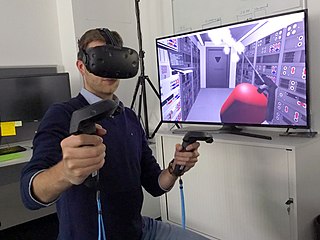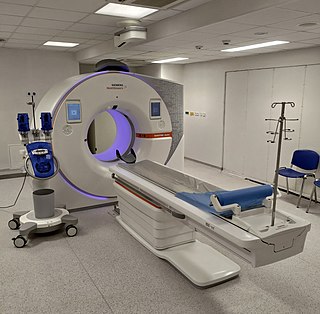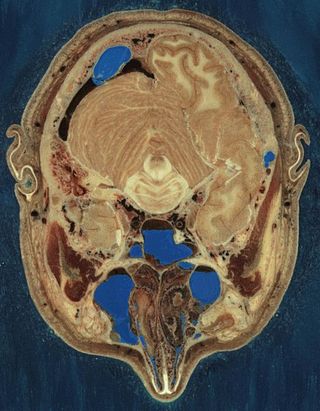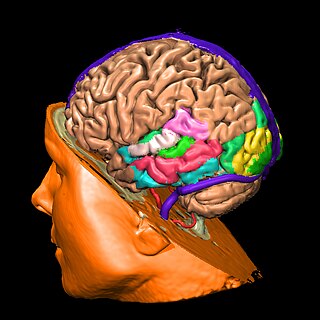
Virtual reality (VR) is a simulated experience that employs 3D near-eye displays and pose tracking to give the user an immersive feel of a virtual world. Applications of virtual reality include entertainment, education and business. VR is one of the key technologies in the reality-virtuality continuum. As such, it is different from other digital visualization solutions, such as augmented virtuality and augmented reality.

A simulation is an imitative representation of a process or system that could exist in the real world. In this broad sense, simulation can often be used interchangeably with model. Sometimes a clear distinction between the two terms is made, in which simulations require the use of models; the model represents the key characteristics or behaviors of the selected system or process, whereas the simulation represents the evolution of the model over time. Another way to distinguish between the terms is to define simulation as experimentation with the help of a model. This definition includes time-independent simulations. Often, computers are used to execute the simulation.

A computed tomography scan, formerly called computed axial tomography scan, is a medical imaging technique used to obtain detailed internal images of the body. The personnel that perform CT scans are called radiographers or radiology technologists. CT scanners use a rotating X-ray tube and a row of detectors placed in a gantry to measure X-ray attenuations by different tissues inside the body. The multiple X-ray measurements taken from different angles are then processed on a computer using tomographic reconstruction algorithms to produce tomographic (cross-sectional) images of a body. CT scans can be used in patients with metallic implants or pacemakers, for whom magnetic resonance imaging (MRI) is contraindicated.

The Holodeck is a fictional device from the television franchise Star Trek which uses "holograms" to create a realistic 3D simulation of a real or imaginary setting, in which participants can freely interact with the environment as well as objects and characters, and sometimes a predefined narrative.

The Visible Human Project is an effort to create a detailed data set of cross-sectional photographs of the human body, in order to facilitate anatomy visualization applications. It is used as a tool for the progression of medical findings, in which these findings link anatomy to its audiences. A male and a female cadaver were cut into thin slices, which were then photographed and digitized. The project is run by the U.S. National Library of Medicine (NLM) under the direction of Michael J. Ackerman. Planning began in 1986; the data set of the male was completed in November 1994 and the one of the female in November 1995. The project can be viewed today at the NLM in Bethesda, Maryland. There are currently efforts to repeat this project with higher resolution images but only with parts of the body instead of a cadaver.

Motion capture is the process of recording the movement of objects or people. It is used in military, entertainment, sports, medical applications, and for validation of computer vision and robots. In films, television shows and video games, motion capture refers to recording actions of human actors and using that information to animate digital character models in 2D or 3D computer animation. When it includes face and fingers or captures subtle expressions, it is often referred to as performance capture. In many fields, motion capture is sometimes called motion tracking, but in filmmaking and games, motion tracking usually refers more to match moving.
Interactive storytelling is a form of digital entertainment in which the storyline is not predetermined. The author creates the setting, characters, and situation which the narrative must address, but the user experiences a unique story based on their interactions with the story world. The architecture of an interactive storytelling program includes a drama manager, user model, and agent model to control, respectively, aspects of narrative production, player uniqueness, and character knowledge and behavior. Together, these systems generate characters that act "human," alter the world in real-time reactions to the player, and ensure that new narrative events unfold comprehensibly.

Dissection is the dismembering of the body of a deceased animal or plant to study its anatomical structure. Autopsy is used in pathology and forensic medicine to determine the cause of death in humans. Less extensive dissection of plants and smaller animals preserved in a formaldehyde solution is typically carried out or demonstrated in biology and natural science classes in middle school and high school, while extensive dissections of cadavers of adults and children, both fresh and preserved are carried out by medical students in medical schools as a part of the teaching in subjects such as anatomy, pathology and forensic medicine. Consequently, dissection is typically conducted in a morgue or in an anatomy lab.

In radiography, X-ray microtomography uses X-rays to create cross-sections of a physical object that can be used to recreate a virtual model without destroying the original object. It is similar to tomography and X-ray computed tomography. The prefix micro- is used to indicate that the pixel sizes of the cross-sections are in the micrometre range. These pixel sizes have also resulted in creation of its synonyms high-resolution X-ray tomography, micro-computed tomography, and similar terms. Sometimes the terms high-resolution computed tomography (HRCT) and micro-CT are differentiated, but in other cases the term high-resolution micro-CT is used. Virtually all tomography today is computed tomography.

A virtual retinal display (VRD), also known as a retinal scan display (RSD) or retinal projector (RP), is a display technology that draws a raster display directly onto the retina of the eye.
The term virtual patient is used to describe interactive computer simulations used in health care education to train students on clinical processes such as making diagnoses and therapeutic decisions. Virtual patients attempt to combine modern technologies and game-based learning to facilitate education, and complement real clinical training. The use of virtual patients is increasing in healthcare due to increased demand for healthcare professionals and education of healthcare trainees, and provides learners with a safe practice environment. There are many formats from which a virtual patient may be chosen, but the overarching principle is that of interactivity. Virtual patients typically have mechanisms where information is parsed out in response to the learners, simulating how patients respond to different treatments. Interactivity can be created with questions, specific decision-making tasks, as well as text composition, and it is non-sequential. Most systems provide quantitative and qualitative feedback. In some cases, virtual patients are not full simulations themselves, but are mainly based on paper-based cases. This is because they do not allow for physical examination or an in-depth medical history of an actual patient. There are certain drawbacks, as crucial clinical findings may be missed due to the lack of examining patients in person.
Brian G. Wowk is a Canadian medical physicist and cryobiologist known for the discovery and development of synthetic molecules that mimic the activity of natural antifreeze proteins in cryopreservation applications, sometimes called "ice blockers". As a senior scientist at 21st Century Medicine, Inc., he was a co-developer with Greg Fahy of key technologies enabling cryopreservation of large and complex tissues, including the first successful vitrification and transplantation of a mammalian organ (kidney). Wowk is also known for early theoretical work on future applications of molecular nanotechnology, especially cryonics, nanomedicine, and optics. In the early 1990s he wrote that nanotechnology would revolutionize optics, making possible virtual reality display systems optically indistinguishable from real scenery as in the fictitious Holodeck of Star Trek. These systems were described by Wowk in the chapter "Phased Array Optics" in the 1996 anthology Nanotechnology: Molecular Speculations on Global Abundance, and highlighted in the September 1998 Technology Watch section of Popular Mechanics magazine.
A caveman is a popular stylized characterization of how early humans or hominids looked and behaved. A cave dweller is a real human being who lives in a cave or under a cliff.

In virtual reality (VR), immersion is the perception of being physically present in a non-physical world. The perception is created by surrounding the user of the VR system in images, sound or other stimuli that provide an engrossing total environment.
A Supranet combines physical objects with the Internet. A common example of Supranet is Geotagging
A projection augmented model is an element sometimes employed in virtual reality systems. It consists of a physical three-dimensional model onto which a computer image is projected to create a realistic looking object. Importantly, the physical model is the same geometric shape as the object that the PA model depicts.

VOXEL-MAN is the name of a set of computer programs for creation and visualization of three-dimensional digital models of the human body derived from cross-sectional images of computer tomography, magnetic resonance tomography or photography. It was developed at the University Medical Center Hamburg-Eppendorf. Applications include diagnostic imaging, digital anatomical atlases and surgery simulators. The 3D interactive atlases of anatomy and radiology for brain/skull, inner organs and upper limb are available for free download. The name Voxel-Man is derived from the term voxel, the elementary cuboid component of a digital representation of a three-dimensional object. Occasionally the name Voxel-Man is also used as a general term for a digital representation of the human body.

Computer-generated imagery (CGI) is a specific-technology or application of computer graphics for creating or improving images in art, printed media, simulators, videos and video games. These images are either static or dynamic. CGI both refers to 2D computer graphics and 3D computer graphics with the purpose of designing characters, virtual worlds, or scenes and special effects. The application of CGI for creating/improving animations is called computer animation, or CGI animation.
An in silico clinical trial, also known as a virtual clinical trial, is an individualized computer simulation used in the development or regulatory evaluation of a medicinal product, device, or intervention. While completely simulated clinical trials are not feasible with current technology and understanding of biology, its development would be expected to have major benefits over current in vivo clinical trials, and research on it is being pursued.
Microsoft Holoportation is a project from Microsoft Research that demonstrates real-time holographic communications with the Microsoft Hololens. Holoportation is described as "a new type of 3D capture technology that allows high-quality 3D models of people to be reconstructed, compressed and transmitted anywhere in the world in real time. This allows users wearing virtual or augmented reality displays to see, hear and interact with remote participants in 3D, almost as if they were present in the same physical space. From an audio-visual perspective, communicating and interacting with remote users edges closer to face-to-face communication." The project was launched by Shahram Izadi and his Microsoft team in 2016. In March 2016, Alex Kipman performed a live demonstration of the technology at the TED conference as part of his talk. In 2020, Microsoft Mesh was launched which offered Holoportation capabilities to "project yourself as your most lifelike, photorealistic self in mixed reality to interact as if you are there in person".











